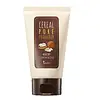What's inside
What's inside
 Key Ingredients
Key Ingredients

 Benefits
Benefits

 Concerns
Concerns

 Ingredients Side-by-side
Ingredients Side-by-side

Oryza Sativa Bran Extract
Skin ConditioningOryza Sativa Bran
AbrasiveGlycerin
HumectantStearic Acid
CleansingLauric Acid
CleansingPotassium Hydroxide
BufferingMyristic Acid
CleansingCocamidopropyl Betaine
CleansingPotassium Cocoyl Glycinate
Juglans Regia Shell Powder
AbrasiveJuglans Regia Seed Extract
Skin ConditioningCastanea Crenata Shell Extract
Skin ConditioningPerilla Ocymoides Seed Extract
AntioxidantLens Esculenta Seed Extract
Skin ProtectingPEG-40 Hydrogenated Castor Oil PCA Isostearate
Skin ConditioningPEG-32
HumectantInulin Lauryl Carbamate
Emulsion StabilisingGlyceryl Stearate
EmollientPEG-100 Stearate
Polyquaternium-7
Water
Skin ConditioningPhenoxyethanol
PreservativeDisodium EDTA
Parfum
MaskingOryza Sativa Bran Extract, Oryza Sativa Bran, Glycerin, Stearic Acid, Lauric Acid, Potassium Hydroxide, Myristic Acid, Cocamidopropyl Betaine, Potassium Cocoyl Glycinate, Juglans Regia Shell Powder, Juglans Regia Seed Extract, Castanea Crenata Shell Extract, Perilla Ocymoides Seed Extract, Lens Esculenta Seed Extract, PEG-40 Hydrogenated Castor Oil PCA Isostearate, PEG-32, Inulin Lauryl Carbamate, Glyceryl Stearate, PEG-100 Stearate, Polyquaternium-7, Water, Phenoxyethanol, Disodium EDTA, Parfum
Glycerin
HumectantWater
Skin ConditioningSodium Cocoyl Glycinate
CleansingCocamidopropyl Betaine
CleansingHydrogenated Castor Oil
EmollientDecyl Glucoside
CleansingParfum
MaskingHydrolyzed Borage Seed Oil Extract
AntioxidantPropanediol
SolventBoerhavia Diffusa Root Extract
Skin ProtectingCitric Acid
BufferingCocos Nucifera Shell Powder
AbrasiveXanthan Gum
EmulsifyingMethylchloroisothiazolinone
PreservativeMethylisothiazolinone
PreservativeGlycerin, Water, Sodium Cocoyl Glycinate, Cocamidopropyl Betaine, Hydrogenated Castor Oil, Decyl Glucoside, Parfum, Hydrolyzed Borage Seed Oil Extract, Propanediol, Boerhavia Diffusa Root Extract, Citric Acid, Cocos Nucifera Shell Powder, Xanthan Gum, Methylchloroisothiazolinone, Methylisothiazolinone
Ingredients Explained
These ingredients are found in both products.
Ingredients higher up in an ingredient list are typically present in a larger amount.
Cocamidopropyl Betaine is a fatty acid created by mixing similar compounds in coconut oil and dimethylaminopropylamine, a compound with two amino groups.
This ingredient is a surfactant and cleanser. It helps gather the dirt, pollutants, and other impurities in your skin to be washed away. It also helps thicken a product and make the texture more creamy.
Being created from coconut oil means Cocamidopropyl Betaine is hydrating for the skin.
While Cocamidopropyl Betaine was believed to be an allergen, a study from 2012 disproved this. It found two compounds in unpure Cocamidopropyl Betaine to be the irritants: aminoamide and 3-dimethylaminopropylamine. High-grade and pure Cocamidopropyl Betaine did not induce allergic reactions during this study.
Learn more about Cocamidopropyl BetaineGlycerin is already naturally found in your skin. It helps moisturize and protect your skin.
A study from 2016 found glycerin to be more effective as a humectant than AHAs and hyaluronic acid.
As a humectant, it helps the skin stay hydrated by pulling moisture to your skin. The low molecular weight of glycerin allows it to pull moisture into the deeper layers of your skin.
Hydrated skin improves your skin barrier; Your skin barrier helps protect against irritants and bacteria.
Glycerin has also been found to have antimicrobial and antiviral properties. Due to these properties, glycerin is often used in wound and burn treatments.
In cosmetics, glycerin is usually derived from plants such as soybean or palm. However, it can also be sourced from animals, such as tallow or animal fat.
This ingredient is organic, colorless, odorless, and non-toxic.
Glycerin is the name for this ingredient in American English. British English uses Glycerol/Glycerine.
Learn more about GlycerinParfum is a catch-all term for an ingredient or more that is used to give a scent to products.
Also called "fragrance", this ingredient can be a blend of hundreds of chemicals or plant oils. This means every product with "fragrance" or "parfum" in the ingredients list is a different mixture.
For instance, Habanolide is a proprietary trade name for a specific aroma chemical. When used as a fragrance ingredient in cosmetics, most aroma chemicals fall under the broad labeling category of “FRAGRANCE” or “PARFUM” according to EU and US regulations.
The term 'parfum' or 'fragrance' is not regulated in many countries. In many cases, it is up to the brand to define this term.
For instance, many brands choose to label themselves as "fragrance-free" because they are not using synthetic fragrances. However, their products may still contain ingredients such as essential oils that are considered a fragrance by INCI standards.
One example is Calendula flower extract. Calendula is an essential oil that still imparts a scent or 'fragrance'.
Depending on the blend, the ingredients in the mixture can cause allergies and sensitivities on the skin. Some ingredients that are known EU allergens include linalool and citronellol.
Parfum can also be used to mask or cover an unpleasant scent.
The bottom line is: not all fragrances/parfum/ingredients are created equally. If you are worried about fragrances, we recommend taking a closer look at an ingredient. And of course, we always recommend speaking with a professional.
Learn more about ParfumWater. It's the most common cosmetic ingredient of all. You'll usually see it at the top of ingredient lists, meaning that it makes up the largest part of the product.
So why is it so popular? Water most often acts as a solvent - this means that it helps dissolve other ingredients into the formulation.
You'll also recognize water as that liquid we all need to stay alive. If you see this, drink a glass of water. Stay hydrated!
Learn more about Water